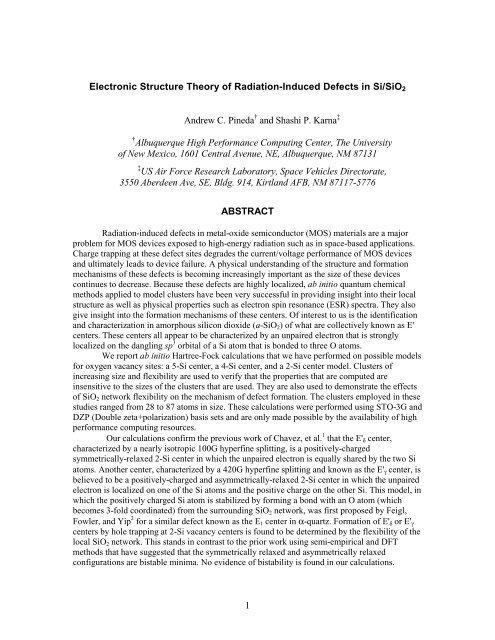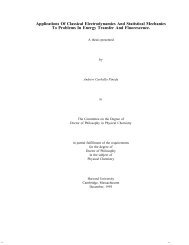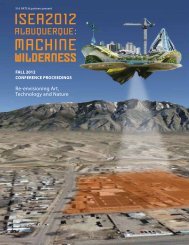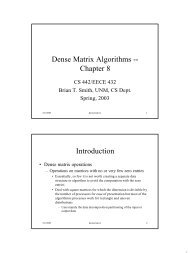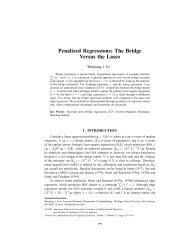Electronic Structure Theory of Radiation-Induced Defects in Si/SiO2
Electronic Structure Theory of Radiation-Induced Defects in Si/SiO2
Electronic Structure Theory of Radiation-Induced Defects in Si/SiO2
Create successful ePaper yourself
Turn your PDF publications into a flip-book with our unique Google optimized e-Paper software.
<strong>Electronic</strong> <strong>Structure</strong> <strong>Theory</strong> <strong>of</strong> <strong>Radiation</strong>-<strong>Induced</strong> <strong>Defects</strong> <strong>in</strong> <strong>Si</strong>/<strong>Si</strong>O 2<br />
Andrew C. P<strong>in</strong>eda † and Shashi P. Karna ‡<br />
† Albuquerque High Performance Comput<strong>in</strong>g Center, The University<br />
<strong>of</strong> New Mexico, 1601 Central Avenue, NE, Albuquerque, NM 87131<br />
‡ US Air Force Research Laboratory, Space Vehicles Directorate,<br />
3550 Aberdeen Ave, SE, Bldg. 914, Kirtland AFB, NM 87117-5776<br />
ABSTRACT<br />
<strong>Radiation</strong>-<strong>in</strong>duced defects <strong>in</strong> metal-oxide semiconductor (MOS) materials are a major<br />
problem for MOS devices exposed to high-energy radiation such as <strong>in</strong> space-based applications.<br />
Charge trapp<strong>in</strong>g at these defect sites degrades the current/voltage performance <strong>of</strong> MOS devices<br />
and ultimately leads to device failure. A physical understand<strong>in</strong>g <strong>of</strong> the structure and formation<br />
mechanisms <strong>of</strong> these defects is becom<strong>in</strong>g <strong>in</strong>creas<strong>in</strong>gly important as the size <strong>of</strong> these devices<br />
cont<strong>in</strong>ues to decrease. Because these defects are highly localized, ab <strong>in</strong>itio quantum chemical<br />
methods applied to model clusters have been very successful <strong>in</strong> provid<strong>in</strong>g <strong>in</strong>sight <strong>in</strong>to their local<br />
structure as well as physical properties such as electron sp<strong>in</strong> resonance (ESR) spectra. They also<br />
give <strong>in</strong>sight <strong>in</strong>to the formation mechanisms <strong>of</strong> these centers. Of <strong>in</strong>terest to us is the identification<br />
and characterization <strong>in</strong> amorphous silicon dioxide (a-<strong>Si</strong>O 2 ) <strong>of</strong> what are collectively known as E'<br />
centers. These centers all appear to be characterized by an unpaired electron that is strongly<br />
localized on the dangl<strong>in</strong>g sp 3 orbital <strong>of</strong> a <strong>Si</strong> atom that is bonded to three O atoms.<br />
We report ab <strong>in</strong>itio Hartree-Fock calculations that we have performed on possible models<br />
for oxygen vacancy sites: a 5-<strong>Si</strong> center, a 4-<strong>Si</strong> center, and a 2-<strong>Si</strong> center model. Clusters <strong>of</strong><br />
<strong>in</strong>creas<strong>in</strong>g size and flexibility are used to verify that the properties that are computed are<br />
<strong>in</strong>sensitive to the sizes <strong>of</strong> the clusters that are used. They are also used to demonstrate the effects<br />
<strong>of</strong> <strong>Si</strong>O 2 network flexibility on the mechanism <strong>of</strong> defect formation. The clusters employed <strong>in</strong> these<br />
studies ranged from 28 to 87 atoms <strong>in</strong> size. These calculations were performed us<strong>in</strong>g STO-3G and<br />
DZP (Double zeta+polarization) basis sets and are only made possible by the availability <strong>of</strong> high<br />
performance comput<strong>in</strong>g resources.<br />
Our calculations confirm the previous work <strong>of</strong> Chavez, et al. 1 that the E' δ center,<br />
characterized by a nearly isotropic 100G hyperf<strong>in</strong>e splitt<strong>in</strong>g, is a positively-charged<br />
symmetrically-relaxed 2-<strong>Si</strong> center <strong>in</strong> which the unpaired electron is equally shared by the two <strong>Si</strong><br />
atoms. Another center, characterized by a 420G hyperf<strong>in</strong>e splitt<strong>in</strong>g and known as the E' γ center, is<br />
believed to be a positively-charged and asymmetrically-relaxed 2-<strong>Si</strong> center <strong>in</strong> which the unpaired<br />
electron is localized on one <strong>of</strong> the <strong>Si</strong> atoms and the positive charge on the other <strong>Si</strong>. This model, <strong>in</strong><br />
which the positively charged <strong>Si</strong> atom is stabilized by form<strong>in</strong>g a bond with an O atom (which<br />
becomes 3-fold coord<strong>in</strong>ated) from the surround<strong>in</strong>g <strong>Si</strong>O 2 network, was first proposed by Feigl,<br />
Fowler, and Yip 2 for a similar defect known as the E 1 center <strong>in</strong> α-quartz. Formation <strong>of</strong> E' δ or E' γ<br />
centers by hole trapp<strong>in</strong>g at 2-<strong>Si</strong> vacancy centers is found to be determ<strong>in</strong>ed by the flexibility <strong>of</strong> the<br />
local <strong>Si</strong>O 2 network. This stands <strong>in</strong> contrast to the prior work us<strong>in</strong>g semi-empirical and DFT<br />
methods that have suggested that the symmetrically relaxed and asymmetrically relaxed<br />
configurations are bistable m<strong>in</strong>ima. No evidence <strong>of</strong> bistability is found <strong>in</strong> our calculations.<br />
1
INTRODUCTION<br />
In this paper, we review some <strong>of</strong> the research by our group over the past few years<br />
<strong>in</strong>to the electronic structure 1, 3 and formation mechanisms 4 <strong>of</strong> po<strong>in</strong>t defects <strong>in</strong> amorphous<br />
<strong>Si</strong>O 2 (a-<strong>Si</strong>O 2 ). The primary focus <strong>of</strong> these studies has been a class <strong>of</strong> defects known as the<br />
E’ centers. The E’ centers are perhaps the most extensively studied po<strong>in</strong>t defects <strong>in</strong><br />
a-<strong>Si</strong>O 5,6 2 and belong to a family <strong>of</strong> five positively charged defect centers identified to date<br />
<strong>in</strong> th<strong>in</strong> <strong>Si</strong>O 2 films. 7,8 The E’ centers, as identified via electron sp<strong>in</strong> resonance (ESR)<br />
spectroscopy, are associated with an unpaired electron centered on (a) a s<strong>in</strong>gle <strong>Si</strong> atom<br />
adjacent to vacant oxygen (V O ) sites or (b) on multiple <strong>Si</strong> atoms with<strong>in</strong> the region<br />
conta<strong>in</strong><strong>in</strong>g excess <strong>Si</strong> centers (ESC) or <strong>Si</strong> "islands" <strong>in</strong> the oxide network. <strong>Si</strong>milarly, triplet<br />
centers, with two unpaired electrons, are also believed to be associated with vacancy sites.<br />
These centers are believed to be the primary hole trap centers <strong>in</strong> the metal-oxidesemiconductor<br />
(MOS) devices 9,10 where they affect electrical properties such as leakage<br />
currents, current-voltage (I/V) behavior, and ultimately device reliability. Although the<br />
exact mechanism <strong>of</strong> hole trapp<strong>in</strong>g by oxygen vacancy sites rema<strong>in</strong>s unknown, it is widely<br />
accepted that network relaxation lead<strong>in</strong>g to the creation <strong>of</strong> deep trap levels <strong>in</strong> the <strong>Si</strong>O 2 band<br />
gap is one <strong>of</strong> the consequences <strong>of</strong> charge trapp<strong>in</strong>g. The latter phenomenon causes a longterm<br />
build up <strong>of</strong> oxide-trapped positive charge. However, the exact nature <strong>of</strong> the network<br />
relaxation that results <strong>in</strong> the long term build up <strong>of</strong> oxide charge follow<strong>in</strong>g charge trapp<strong>in</strong>g<br />
rema<strong>in</strong>s unknown to date. The deleterious effect <strong>of</strong> this charge buildup on device behavior<br />
has become much more significant as semiconductor devices have decreased <strong>in</strong> size.<br />
Therefore, the development <strong>of</strong> an understand<strong>in</strong>g <strong>of</strong> the microscopic structure, stability,<br />
2
formation mechanisms, and electrical characteristics <strong>of</strong> these centers have been the focus a<br />
great deal <strong>of</strong> attention over the past decade.<br />
Microscopic structure <strong>of</strong> defect centers<br />
Among the various flavors <strong>of</strong> the E’ centers <strong>in</strong> a-<strong>Si</strong>O 2 , the E’ γ center appears to be<br />
the most common high-energy radiation-<strong>in</strong>duced oxygen vacancy center generated <strong>in</strong><br />
oxides prepared under a variety <strong>of</strong> conditions. The characteristic features <strong>of</strong> the ESR<br />
spectrum <strong>of</strong> the E’ γ center are: (a) a 420 G splitt<strong>in</strong>g <strong>in</strong> the hyperf<strong>in</strong>e spectrum and (b) an<br />
11- 13<br />
anisotropic g-tensor (g 11 =2.0018, g 22 =2.0006, g 33 =2.0003). Extensive experimental<br />
and theoretical studies, 2,14-16 performed <strong>in</strong> the past, have identified this center as a pair <strong>of</strong><br />
silicon atoms, one bear<strong>in</strong>g an unpaired electron sp<strong>in</strong> and the other bear<strong>in</strong>g a positive<br />
charge, adjo<strong>in</strong><strong>in</strong>g an oxygen vacancy site (<strong>Si</strong> ↑ —<strong>Si</strong> + ). The unpaired electron is localized<br />
primarily on an sp 3 bond<strong>in</strong>g orbital <strong>of</strong> a tetrahedral <strong>Si</strong>. The positively charged <strong>Si</strong> atom is far<br />
removed from its tetrahedral counterpart and believed to be bonded to a triply coord<strong>in</strong>ated<br />
O atom <strong>in</strong> the oxide network. From the po<strong>in</strong>t <strong>of</strong> view <strong>of</strong> the ESR experiment, the important<br />
feature <strong>of</strong> this center is that the unpaired electron sp<strong>in</strong> is localized on a s<strong>in</strong>gle <strong>Si</strong> atom.<br />
In contrast to the E' γ center, which has been known for over 30 years, the E’ δ center<br />
has been detected only recently. This center was first detected by Griscom and Frieble 11 <strong>in</strong><br />
100 keV x-ray irradiated bulk silica conta<strong>in</strong><strong>in</strong>g a high density <strong>of</strong> chlor<strong>in</strong>e impurity. Later, it<br />
was also detected <strong>in</strong> γ-ray irradiated high purity silica glasses. 17 Vanheusden and<br />
Stesmans 18 detected this center <strong>in</strong> buried oxide (BOX) layers formed by O + implantation<br />
dur<strong>in</strong>g the separation by implantation <strong>of</strong> oxygen (SIMOX) process. <strong>Si</strong>milar observations<br />
have been reported by Warren et al. 19 In recent years, this center has also been detected <strong>in</strong><br />
the thermally grown oxide films upon anneal<strong>in</strong>g 20-24 and <strong>in</strong> x-ray irradiated high purity<br />
3
silica glass. 25 The characteristic features <strong>of</strong> the E' δ centers are (a) a 100 G doublet hyperf<strong>in</strong>e<br />
splitt<strong>in</strong>g, and (b) a nearly isotropic g-tensor (g 11 =2.0018, g 22 =2.0021, g 33 =2.0021) <strong>in</strong> the<br />
electron sp<strong>in</strong> resonance (ESR) spectrum. 11,25 The hyperf<strong>in</strong>e splitt<strong>in</strong>g and the g-tensor are<br />
attributed to 29 <strong>Si</strong> centers <strong>in</strong> the oxide samples. 11,18,19,25 Another important feature <strong>of</strong> this<br />
center, as observed from the ESR spectrum <strong>of</strong> irradiated glass samples, 11,17,25 is the<br />
simultaneous appearance <strong>of</strong> a triplet state spectrum. The charge state <strong>of</strong> E' δ is believed to<br />
be positive. 18,19<br />
While the total sp<strong>in</strong> and the charge state <strong>of</strong> the E' δ center extracted from the ESR<br />
and the electrical measurements are believed to be well established, the exact nature <strong>of</strong> its<br />
microscopic structure has been the subject <strong>of</strong> considerable debate. Analysis <strong>of</strong> the ESR<br />
spectrum for this center, vis-à-vis that <strong>of</strong> the more extensively studied E' γ center <strong>in</strong><br />
a-<strong>Si</strong>O 2 , 5-13 suggests that the unpaired electron sp<strong>in</strong> <strong>in</strong> the E' δ center is delocalized over four,<br />
nearly equivalent, <strong>Si</strong> atoms. S<strong>in</strong>ce a-<strong>Si</strong>O 2 is a network <strong>of</strong> tetravalent <strong>Si</strong> atoms connected<br />
via divalent bridg<strong>in</strong>g O atoms, an atomic arrangement with four equivalent <strong>Si</strong> atoms<br />
requires multiple-oxygen vacancies or doma<strong>in</strong>s <strong>of</strong> unoxidized, tetrahedrally-connected <strong>Si</strong><br />
atoms, also referred to as oxygen deficient centers (ODCs), <strong>in</strong> the oxide. These arguments<br />
have led a number <strong>of</strong> groups to propose multiple-oxygen vacancy models. For example,<br />
Griscom and Frieble 11 proposed a model <strong>in</strong> which the unpaired electron sp<strong>in</strong> is delocalized<br />
over four tetrahedral bonds <strong>of</strong> equivalent but different <strong>Si</strong> atoms. The model proposed by<br />
Vanheusden and Stesmans 18 and Warren et al. 19 <strong>in</strong>volves delocalization <strong>of</strong> the unpaired<br />
electron sp<strong>in</strong> over four equivalent <strong>Si</strong> atoms connected to a central tetrahedral <strong>Si</strong> atom (the<br />
five-<strong>Si</strong> atom model).<br />
4
In contrast, the model proposed by Zhang and Leisure 25 <strong>in</strong>volves delocalization <strong>of</strong><br />
the electron sp<strong>in</strong> over four equivalent <strong>Si</strong> atoms around a <strong>Si</strong>O 4 vacancy (the four-<strong>Si</strong> atom<br />
model). In addition to the multi-oxygen vacancy models, mono-oxygen vacancy models<br />
have also been proposed <strong>in</strong> the literature 17,21 to describe the local atomic configuration <strong>of</strong><br />
the E' δ center. In these models, the unpaired electron sp<strong>in</strong> is believed to be localized either<br />
on a <strong>Si</strong>-<strong>Si</strong> dimer 17 or on a s<strong>in</strong>gle <strong>Si</strong> atom 21 as <strong>in</strong> the case <strong>of</strong> the E' γ center (the two-<strong>Si</strong> atom<br />
model).<br />
The triplet state species with two unpaired electrons hav<strong>in</strong>g parallel sp<strong>in</strong>s (total<br />
sp<strong>in</strong>, S=1, sp<strong>in</strong> multiplicity, M s =3) have only been detected <strong>in</strong> irradiated bulk silica<br />
samples. 11,17,22 The triplet-state center has a number <strong>of</strong> very <strong>in</strong>terest<strong>in</strong>g properties. For<br />
example: (a) it always appears <strong>in</strong> the samples where E’ δ is observed; (b) it is observed <strong>in</strong><br />
the samples which exhibit a 5 eV absorption followed by a 4.4 eV photolum<strong>in</strong>escence; (c)<br />
it is only found <strong>in</strong> low-OH oxygen-deficient samples with no Cl impurity; and (d) its ESR<br />
properties (a nearly isotropic g-value=2.002 and a hypef<strong>in</strong>e splitt<strong>in</strong>g <strong>of</strong> 134 G) are<br />
strik<strong>in</strong>gly similar to those <strong>of</strong> the E’ δ center. Furthermore, its anneal<strong>in</strong>g behavior is also<br />
very similar to that <strong>of</strong> the E’ δ center. Previous workers have suggested 11,17,25 that the two<br />
paramagnetic centers may have common local atomic structure due to the observed<br />
similarities <strong>in</strong> the properties <strong>of</strong> the triplet-state and the E’ δ centers.<br />
An <strong>in</strong>itial attempt to establish the microscopic structure <strong>of</strong> these defects <strong>in</strong> a-<strong>Si</strong>O 2<br />
via quantum mechanical calculations was the study by Chavez et al. 1 <strong>of</strong> the E’ δ center.<br />
They exam<strong>in</strong>ed the proposed atomic models for the E' δ center 14,18,25 by ab <strong>in</strong>itio Hartree-<br />
Fock (HF) calculations <strong>of</strong> the stable geometry, energy, and sp<strong>in</strong> properties <strong>of</strong> model<br />
clusters. Their calculations suggested that subsequent to the hole trapp<strong>in</strong>g, the free electron<br />
5
sp<strong>in</strong> prefers to localize on a pair <strong>of</strong> <strong>Si</strong> atoms regardless <strong>of</strong> the number (five, four, or two) <strong>of</strong><br />
<strong>Si</strong> atoms around oxygen vacancy. 1 Furthermore, the calculated sp<strong>in</strong> density and the<br />
hyperf<strong>in</strong>e coupl<strong>in</strong>g tensor on the two participat<strong>in</strong>g <strong>Si</strong> atoms showed excellent agreement<br />
with the experimental ESR data. From these results, they concluded that the E’ δ center<br />
most probably resulted from an equal distribution <strong>of</strong> the unpaired electron sp<strong>in</strong> over two<br />
equivalent <strong>Si</strong> atoms and suggested that the E’ δ center was a symmetrical variant <strong>of</strong> the E’ γ<br />
center. 1 In the latter case, the sp<strong>in</strong> is asymmetrically localized on a s<strong>in</strong>gle <strong>Si</strong> center around<br />
a mono-oxygen vacancy.<br />
S<strong>in</strong>ce Chavez et al. 1 used relatively small atomic clusters to model the E’ δ center, it<br />
was not clear if the size <strong>of</strong> the clusters had any <strong>in</strong>fluence on the calculated results for the<br />
sp<strong>in</strong> density. They also did not study the triplet-state centers. 1 In view <strong>of</strong> the importance<br />
effects <strong>of</strong> oxygen vacancy related po<strong>in</strong>t defects on the reliability <strong>of</strong> MOS devices, we have<br />
performed ab <strong>in</strong>itio HF calculations on the E’ δ centers employ<strong>in</strong>g extended sets <strong>of</strong> atomic<br />
basis functions and much larger model cluster structures. Because <strong>of</strong> their size, these<br />
calculations require the use <strong>of</strong> high performance parallel comput<strong>in</strong>g resources. We have<br />
performed similar calculations on the triplet-state centers employ<strong>in</strong>g somewhat smaller<br />
clusters. The results for the E’ δ centers 1,3 us<strong>in</strong>g clusters <strong>of</strong> different sizes are all consistent<br />
with one another suggest<strong>in</strong>g that the observed ESR spectrum results from an unpaired<br />
electron distributed over a pair <strong>of</strong> <strong>Si</strong> atoms arranged around a mono-oxygen vacancy. The<br />
calculated results for the ESR hyperf<strong>in</strong>e coupl<strong>in</strong>g tensor for model triplet-state structures<br />
are too large compared with the experiment. 11,17,25<br />
6
Hole trapp<strong>in</strong>g mechanism<br />
Accord<strong>in</strong>g to a popular model, proposed by Feigl, Fowler, and Yip 2 (FFY) a<br />
quarter <strong>of</strong> a century ago, trapp<strong>in</strong>g <strong>of</strong> a hole by an oxygen vacancy site <strong>in</strong> α-quartz causes an<br />
asymmetric relaxation <strong>of</strong> the <strong>Si</strong> atoms adjacent to the vacancy. Specifically, the hole is<br />
localized on a silicon atom that moves away from its orig<strong>in</strong>al position <strong>in</strong> the vacancy<br />
through the plane <strong>of</strong> its three adjo<strong>in</strong><strong>in</strong>g oxygen atoms where it is stabilized by bond<strong>in</strong>g to<br />
an oxygen atom from the surround<strong>in</strong>g network while an unpaired electron is localized on<br />
another three-fold coord<strong>in</strong>ated silicon atom that essentially rema<strong>in</strong>s fixed at its orig<strong>in</strong>al<br />
position <strong>in</strong> the vacancy. The unpaired electron occupies one <strong>of</strong> the dangl<strong>in</strong>g sp 3 bonds <strong>of</strong><br />
the undisplaced silicon atom. This model, which was orig<strong>in</strong>ally proposed to expla<strong>in</strong> the<br />
observation <strong>of</strong> electron sp<strong>in</strong> resonance (ESR) detection <strong>of</strong> an oxygen vacancy center <strong>in</strong> α-<br />
quartz known as the E' 1 center, is widely used to expla<strong>in</strong> the formation mechanism and<br />
local atomic structure <strong>of</strong> the related E' γ defect center <strong>in</strong> a-<strong>Si</strong>O 2 . Although it has not been<br />
verified experimentally to date, the most appeal<strong>in</strong>g feature <strong>of</strong> the FFY model lies <strong>in</strong> its<br />
ability to provide a physical basis to expla<strong>in</strong> the localization <strong>of</strong> the unpaired electron sp<strong>in</strong><br />
follow<strong>in</strong>g hole trapp<strong>in</strong>g on a s<strong>in</strong>gle silicon atom, as evidenced from the ESR spectrum <strong>of</strong><br />
the E' γ center.<br />
The FFY model is supported by quantum mechanical semi-empirical calculations<br />
with<strong>in</strong> the cluster approach 26 and density functional theory (DFT) calculations with<strong>in</strong> the<br />
supercell approach 27 which suggest that upon hole trapp<strong>in</strong>g, an oxygen vacancy relaxes<br />
asymmetrically with a lower<strong>in</strong>g <strong>of</strong> the total energy <strong>of</strong> the system by about 0.3-0.4 eV. The<br />
DFT calculations also suggest that the asymmetric relaxation <strong>of</strong> the network does not occur<br />
7
spontaneously after hole trapp<strong>in</strong>g by an oxygen vacancy, but rather the process <strong>in</strong>volves an<br />
energy barrier <strong>of</strong> about 0.1-0.4 eV. 27<br />
Despite its widespread appeal, the FFY model fails to expla<strong>in</strong> a number <strong>of</strong><br />
important features related to charge trapp<strong>in</strong>g at an oxygen vacancy <strong>in</strong> a-<strong>Si</strong>O 2 , or its charge<br />
state. One such example is the ESR observation <strong>of</strong> the E' δ center. 11,17,18,24,25 Our group's ab<br />
<strong>in</strong>itio quantum mechanical calculations, 1,3 performed on model <strong>Si</strong>O 2 clusters, have<br />
established this center to be a hole trapped at a simple mono-oxygen vacancy site. The E' δ<br />
center results from a hole trapped at an oxygen vacancy site <strong>in</strong> which the unpaired electron<br />
sp<strong>in</strong> is shared equally by two silicon atoms. The hole trapp<strong>in</strong>g <strong>in</strong> this case causes a<br />
"symmetric relaxation" that leads to a slight <strong>in</strong>crease <strong>in</strong> the <strong>in</strong>ternuclear distance between<br />
the two <strong>Si</strong> atoms adjacent to the relaxed neutral oxygen vacancy. This suggests that<br />
asymmetric relaxation <strong>of</strong> the <strong>Si</strong>O 2 network is not the only effect caused by hole trapp<strong>in</strong>g at<br />
an oxygen vacancy center <strong>in</strong> a-<strong>Si</strong>O 2 .<br />
The FFY model also fails to describe the neutral E' centers, also known as hemi-E'<br />
(E' h ) centers, <strong>in</strong> a-<strong>Si</strong>O 2 . 28-30 Their ESR features, <strong>in</strong>clud<strong>in</strong>g the characteristic resonance<br />
position <strong>of</strong> the spectrum, the g-tensor, and the electron sp<strong>in</strong> - nuclear sp<strong>in</strong> hyperf<strong>in</strong>e<br />
coupl<strong>in</strong>g tensor, are remarkably close to those observed for the E' γ centers. The experiments<br />
and ab <strong>in</strong>itio quantum mechanical calculations agree on the fact that the unpaired electron<br />
is localized on a dangl<strong>in</strong>g sp 3 bond at a three-fold coord<strong>in</strong>ated silicon center. It is therefore<br />
not clear whether hole trapp<strong>in</strong>g is a necessary condition for the observation <strong>of</strong> the so-called<br />
E' γ centers, s<strong>in</strong>ce the charge states <strong>of</strong> these defects have never been established<br />
unambiguously.<br />
8
In light <strong>of</strong> these facts, it is important to develop an improved understand<strong>in</strong>g <strong>of</strong> the<br />
microscopic effects <strong>of</strong> charge trapp<strong>in</strong>g by oxygen vacancy centers <strong>in</strong> a-<strong>Si</strong>O 2 . It is clear,<br />
however, that the present model <strong>of</strong> the charge trapp<strong>in</strong>g by an oxygen vacancy does not<br />
fully account for all known effects. Therefore, it is important to develop a more<br />
comprehensive understand<strong>in</strong>g <strong>of</strong> the effect <strong>of</strong> charge trapp<strong>in</strong>g by oxygen vacancy sites <strong>in</strong> a-<br />
<strong>Si</strong>O 2 . In order to ga<strong>in</strong> such an understand<strong>in</strong>g, we have performed ab <strong>in</strong>itio Hartree-Fock<br />
calculations on model <strong>Si</strong>O 2 clusters <strong>of</strong> vary<strong>in</strong>g size and geometrical features. Attention is<br />
focused on (a) the energy <strong>of</strong> oxygen vacancy formation, ∆E f (V O ) , <strong>in</strong> the neutral and<br />
positive charge state and (b) changes <strong>in</strong> the structural features follow<strong>in</strong>g hole trapp<strong>in</strong>g by<br />
an oxygen vacancy.<br />
Our results suggest that both ∆E f (V O ) and the structural changes for neutral and<br />
positively-charged oxygen vacancies depend upon the start<strong>in</strong>g local structure <strong>of</strong> the <strong>Si</strong>O 2<br />
network. The technical details <strong>of</strong> the calculations are described <strong>in</strong> the follow<strong>in</strong>g section.<br />
Subsequently, the results <strong>of</strong> the calculation are presented and discussed. The ma<strong>in</strong> f<strong>in</strong>d<strong>in</strong>gs<br />
<strong>of</strong> the study are then summarized <strong>in</strong> the conclusion.<br />
CALCULATIONS<br />
The model clusters used <strong>in</strong> the studies that we report on are shown <strong>in</strong> Figures 1<br />
through 4. Model A represents a defect consist<strong>in</strong>g <strong>of</strong> an island <strong>of</strong> five <strong>Si</strong> atoms. Shown <strong>in</strong><br />
Figure 1a is the optimized structure <strong>of</strong> the neutral model A. Model B, shown <strong>in</strong> Figure 1b,<br />
represents a defect consist<strong>in</strong>g <strong>of</strong> an island <strong>of</strong> four <strong>Si</strong> atoms. It was derived from model A by<br />
remov<strong>in</strong>g the central <strong>Si</strong> atom. Model C, shown <strong>in</strong> Figure 2a, is the simplest possible<br />
precursor for a 2-<strong>Si</strong> vacancy center. Model D is derived from model C by remov<strong>in</strong>g the<br />
bridg<strong>in</strong>g O atom. Model E, shown <strong>in</strong> Figure 3a, is a larger precursor (39 atoms) for a 2-<strong>Si</strong><br />
9
vacancy center and model F, shown <strong>in</strong> Figure 3b, is the correspond<strong>in</strong>g vacancy. Model<br />
cluster E consists <strong>of</strong> two fused pairs <strong>of</strong> six-atom r<strong>in</strong>gs with alternat<strong>in</strong>g <strong>Si</strong>—O bonds (or <strong>in</strong><br />
the parlance <strong>of</strong> the solid state community, fused pairs <strong>of</strong> three-member r<strong>in</strong>gs where<br />
"member" refers only to the number <strong>of</strong> silicon atoms <strong>in</strong> the r<strong>in</strong>gs) bridged by a s<strong>in</strong>gle<br />
oxygen atom. Model F was generated by remov<strong>in</strong>g a bridg<strong>in</strong>g O atom from the neutral<br />
oxide cluster, model E. Model G, shown <strong>in</strong> Figure 4a, is the largest precursor cluster (87<br />
atoms) used <strong>in</strong> our study. It consists <strong>of</strong> two fused pairs <strong>of</strong> twelve-atom (six-member) r<strong>in</strong>gs<br />
bridged by a s<strong>in</strong>gle oxygen atom. Models H and I, were generated from model G by<br />
remov<strong>in</strong>g the bridg<strong>in</strong>g oxygen atom and optimiz<strong>in</strong>g the structures <strong>in</strong> the neutral (Figure<br />
4b) and positive charge (Figure 4c) states, respectively. The largest spheres, colored black,<br />
<strong>in</strong> the figures represent the <strong>Si</strong> atoms, the medium-sized spheres, <strong>in</strong> red, represent the O<br />
atoms and the small outer spheres, <strong>in</strong> white, represent H atoms. The H atoms were used to<br />
saturate the valency <strong>of</strong> the outer O atoms.<br />
In what follows, we will also refer to oxygen vacancy sites derived from a<br />
particular precursor, X, as V q O (X), where q denotes the charge <strong>of</strong> the site. This notation is<br />
more convenient for some discussions as well as <strong>in</strong> the tables and figures.<br />
The total energy and the sp<strong>in</strong> density <strong>of</strong> the positively charged clusters were<br />
calculated by the ab <strong>in</strong>itio unrestricted Hartree-Fock (UHF) method. For the neutral<br />
clusters, properties were calculated us<strong>in</strong>g the restricted Hartree-Fock (RHF) method. A<br />
double zeta Cartesian Gaussian basis set augmented by a six-component d polarization<br />
function on <strong>Si</strong> and O atoms and a three-component p polarization function on the H atoms<br />
(DZP basis set) was used <strong>in</strong> most calculations. Where noted below, a m<strong>in</strong>imal (STO-3G)<br />
basis set was also used <strong>in</strong> some calculations. Calculations were performed us<strong>in</strong>g the<br />
10
GAMESS 31 and HONDO 32 ab <strong>in</strong>itio electronic structure codes on a wide variety <strong>of</strong><br />
computational platforms. The former was used for total energy and sp<strong>in</strong> density<br />
calculations as well has geometry optimizations. The latter was used for the calculation <strong>of</strong><br />
ESR hyperf<strong>in</strong>e coupl<strong>in</strong>g constants. All atoms were allowed to move <strong>in</strong> the geometry<br />
calculations.<br />
Computational Aspects <strong>of</strong> Our Calculations<br />
Of the two ab <strong>in</strong>itio codes used <strong>in</strong> our calculations, only the GAMESS code has<br />
been parallelized. While we have not yet performed a quantitative analysis <strong>of</strong> the behavior<br />
<strong>of</strong> GAMESS <strong>in</strong> our research, we feel that some qualitative comments about our experiences<br />
with the code are worthwhile.<br />
In this work, we have used several versions <strong>of</strong> the GAMESS code beg<strong>in</strong>n<strong>in</strong>g with<br />
the January 6, 1998 release and cont<strong>in</strong>u<strong>in</strong>g through the June 1999 release. We have also<br />
used the GAMESS code on a number <strong>of</strong> computational platforms <strong>in</strong>clud<strong>in</strong>g a variety <strong>of</strong><br />
IBM SP2's (66MHz P2 th<strong>in</strong> nodes at the Albuquerque High Performance Comput<strong>in</strong>g<br />
Center, 66MHz P2 th<strong>in</strong> nodes and 160MHz P2SC th<strong>in</strong> nodes at the Maui High<br />
Performance Comput<strong>in</strong>g Center, and similar nodes at the Aeronautical Systems Center),<br />
SGI Orig<strong>in</strong> 2000's (at AHPCC and ASC), and a 64-node L<strong>in</strong>ux-based Dual Pentium II 450<br />
MHz SMP Superclusters (at AHPCC) us<strong>in</strong>g Myr<strong>in</strong>et-based communications.<br />
More recently, we have been us<strong>in</strong>g L<strong>in</strong>ux Superclusters with either Myr<strong>in</strong>et-based<br />
or Gigabit Ethernet-based communications, CPU speeds from 450MHz to 550MHz, and 2<br />
to 4 processors per node. Among the issues we are fac<strong>in</strong>g with runn<strong>in</strong>g such large problems<br />
these new platforms are what we suspect are memory allocation problems with<strong>in</strong><br />
communications driver rout<strong>in</strong>es. Debugg<strong>in</strong>g these problems is made challeng<strong>in</strong>g by the fact<br />
that errors crop up only after the code has been runn<strong>in</strong>g for many hours.<br />
11
Another difficult challenge <strong>in</strong> perform<strong>in</strong>g these calculations is that the time required<br />
for many calculations, especially the job queues, usually exceeds the maximum time limits<br />
<strong>of</strong> the batch queues at most high performance comput<strong>in</strong>g centers. A rough <strong>in</strong>dication <strong>of</strong> the<br />
typical requirements is provided by Table 1 where we give some data on the total amount<br />
<strong>of</strong> process<strong>in</strong>g power used <strong>in</strong> study<strong>in</strong>g the various model clusters appear<strong>in</strong>g <strong>in</strong> this work.<br />
A detailed analysis <strong>of</strong> the performance <strong>of</strong> the GAMESS code on L<strong>in</strong>ux-based SMP<br />
Superclusters is currently be<strong>in</strong>g undertaken at the AHPCC. We hope to report on this study<br />
at the next DoD User Group meet<strong>in</strong>g.<br />
Calculations to identify the structure <strong>of</strong> the E' δ and triplet centers<br />
In order to identify the local structure <strong>of</strong> the E' δ center, the properties <strong>of</strong> models A,<br />
B, and F were computed <strong>in</strong> the positive charge state (q= +1). Calculations on model A were<br />
performed at the ab <strong>in</strong>itio HF optimized equilibrium geometry <strong>of</strong> the neutral cluster (q=0).<br />
Calculations on model F were performed at the ab <strong>in</strong>itio HF optimized geometry <strong>of</strong> the<br />
neutral oxide cluster (Model E).<br />
For the two-<strong>Si</strong> center model (model C), the ESR hyperf<strong>in</strong>e coupl<strong>in</strong>g constants were<br />
also calculated us<strong>in</strong>g a m<strong>in</strong>imal (STO-3G) and a double-zeta valence (DZP) basis set.<br />
As expla<strong>in</strong>ed below, the calculations on the triplet-state centers were performed on<br />
two-<strong>Si</strong> atom model (model D) only.<br />
Calculations exam<strong>in</strong><strong>in</strong>g formation mechanisms <strong>of</strong> oxygen vacancy centers<br />
Precursor Calculations<br />
The precursor clusters used to generate the model mono-oxygen vacancy clusters <strong>in</strong><br />
the present study are the topmost clusters shown <strong>in</strong> Figures 2 through 4. Model C (Figure<br />
2a) is the simplest model for a two silicon center while clusters E and G essentially model<br />
<strong>Si</strong>—O networks <strong>of</strong> <strong>in</strong>creas<strong>in</strong>g size and flexibility. The optimized atomic configurations <strong>of</strong><br />
12
the neutral precursor clusters C and E were taken from our previous studies. 1,3 The<br />
optimized geometry <strong>of</strong> the precursor cluster G was obta<strong>in</strong>ed by a RHF calculation us<strong>in</strong>g a<br />
m<strong>in</strong>imal (STO-3G) basis set.<br />
Charged and Neutral Mono-Oxygen Vacancy Calculations<br />
Models for neutral mono-oxygen vacancies (V 0 O ) were generated by remov<strong>in</strong>g the<br />
bridg<strong>in</strong>g oxygen atom connect<strong>in</strong>g the two central silicon atoms <strong>in</strong> the precursor clusters and<br />
then optimiz<strong>in</strong>g the result<strong>in</strong>g structures via an ab <strong>in</strong>itio RHF calculation. As <strong>in</strong> the<br />
precursor case, the small and medium neutral vacancy models, V 0 O (C) and V 0 O (E), were<br />
optimized us<strong>in</strong>g a DZP basis set and the large neutral model cluster, V 0 O (G), was optimized<br />
us<strong>in</strong>g a m<strong>in</strong>imal (STO-3G) basis set. Positively charged mono-oxygen vacancies (V +1 O )<br />
were similarly generated by remov<strong>in</strong>g the bridg<strong>in</strong>g oxygen atom and an electron, and then<br />
optimiz<strong>in</strong>g the result<strong>in</strong>g structures via an ab <strong>in</strong>itio unrestricted Hartree-Fock (UHF)<br />
calculation us<strong>in</strong>g the same basis sets.<br />
Distortions <strong>of</strong> the neutral and positively charged vacancies about their respective<br />
equilibrium atomic configurations were also studied by add<strong>in</strong>g or remov<strong>in</strong>g an electron to<br />
the optimized positive and neutral vacancies and optimiz<strong>in</strong>g the structures aga<strong>in</strong>. If no<br />
spontaneous relaxation <strong>of</strong> the positively charged cluster occurred <strong>in</strong> the course <strong>of</strong> the<br />
geometry optimization, then a silicon atom from the vacancy was moved <strong>in</strong>to the adjo<strong>in</strong><strong>in</strong>g<br />
network <strong>in</strong> order to attempt to locate a second energy m<strong>in</strong>imum. The specific details <strong>of</strong><br />
these calculations will be discussed on a case by case basis <strong>in</strong> the next section.<br />
13
RESULTS<br />
<strong>Structure</strong> <strong>of</strong> the E’ center:<br />
The five-<strong>Si</strong> atom model (model A).<br />
The <strong>Si</strong>⎯<strong>Si</strong> bond distances <strong>in</strong> the neutral model A (Figure 1a) cluster are calculated<br />
to be between 2.350 Å and 2.362 Å and the calculated <strong>Si</strong>⎯O bond distances range from<br />
1.628 Å to 1.630 Å, <strong>in</strong> good accord with the literature data. 1 The bonds at the central<br />
silicon atom are very nearly equivalent to each other as is noted from the <strong>Si</strong> o ⎯<strong>Si</strong> c ⎯<strong>Si</strong> o<br />
bond angles which range between 109 0 and 111 0 . The subscript c <strong>in</strong>dicates central and o<br />
<strong>in</strong>dicates outer. The equivalence <strong>of</strong> the outer four <strong>Si</strong> atoms is also noted from the Mulliken<br />
population analysis, which gives a net charge between 1.428389 and 1.449943 for the outer<br />
<strong>Si</strong> atoms. When a hole (q = +1) is placed on this cluster, the net calculated charge on the<br />
outer <strong>Si</strong> atoms is calculated to be between 1.486277 and 1.508052. The total sp<strong>in</strong> density,<br />
ρ 0 , (the excess <strong>of</strong> α over β sp<strong>in</strong>s) calculated for the outer four <strong>Si</strong> atoms are: -0.003626,<br />
0.175657, 0.053748, 0.013128. While the net atomic charges on the <strong>Si</strong> centers are not too<br />
different from each other, the correspond<strong>in</strong>g sp<strong>in</strong> densities differ greatly. It is clear that the<br />
sp<strong>in</strong> density is not equally distributed on the outer four <strong>Si</strong> atoms. Moreover, the value <strong>of</strong><br />
11, 25<br />
the calculated sp<strong>in</strong> density is too small relative to the experimental value <strong>of</strong> about 0.32<br />
for the E’ δ center.<br />
The four-<strong>Si</strong> atom model (model B).<br />
For model B (Figure 1), the calculated values <strong>of</strong> the sp<strong>in</strong> density, ρ 0 , at the four <strong>Si</strong><br />
centers are: 1.018086, 0.993140, -0.221734, and -0.280082. Once aga<strong>in</strong>, it is clear that the<br />
sp<strong>in</strong> density is not equally distributed over the four <strong>Si</strong> atoms. Also, the magnitudes <strong>of</strong> the<br />
calculated sp<strong>in</strong> densities are vastly different from the experimental value. 11,17,25 However,<br />
the sp<strong>in</strong> density seems to be distributed on a pair <strong>of</strong> equivalent <strong>Si</strong> atoms.<br />
14
The two-<strong>Si</strong> atom model (model F,V + O (E)).<br />
For model F (Figure 3b), the calculated sp<strong>in</strong> density, ρ 0 , at the two <strong>Si</strong> atoms are<br />
0.304606 and 0.335135. These values are <strong>in</strong> good agreement with experiment 11,17,25 and<br />
the previously reported theoretical values. 1 The calculated value <strong>of</strong> ρ 0 on the first nearest<br />
neighbor O atoms varies from a low <strong>of</strong> 0.04 to a high <strong>of</strong> 0.06. <strong>Si</strong>milarly, the sp<strong>in</strong><br />
density, ρ 0 , at the second nearest neighbor <strong>Si</strong> atoms is calculated to have a value between<br />
0.002 and 0.005. Nth nearest neighbor atoms (N>2) have still smaller values for ρ 0 . This<br />
suggests that the sp<strong>in</strong> density <strong>in</strong> the two-<strong>Si</strong> atom model is ma<strong>in</strong>ly distributed over the pair<br />
<strong>of</strong> <strong>Si</strong> atoms adjacent to the oxygen vacancy.<br />
The calculated sp<strong>in</strong> properties <strong>of</strong> the two <strong>Si</strong> atoms adjacent to the O vacancy for<br />
these model structures are listed <strong>in</strong> Table 2. Listed <strong>in</strong> the table are the sp<strong>in</strong> density, ρ 0 , the<br />
isotropic hyperf<strong>in</strong>e coupl<strong>in</strong>g constant, a iso , and the pr<strong>in</strong>cipal components <strong>of</strong> the anisotropic<br />
hyperf<strong>in</strong>e coupl<strong>in</strong>g tensor, T. The unit for the hyperf<strong>in</strong>e coupl<strong>in</strong>g constant (a iso , T) is<br />
Gauss (G). The sp<strong>in</strong> density, ρ 0 , provides <strong>in</strong>formation on the s-electron sp<strong>in</strong> density at the<br />
atomic nucleus, <strong>in</strong> this case <strong>Si</strong>, and contributes directly to the isotropic hyperf<strong>in</strong>e coupl<strong>in</strong>g<br />
constant. Electrons <strong>in</strong> the p and higher order angular momentum wavefunctions have zero<br />
density at the nucleus. The anisotropic hyperf<strong>in</strong>e tensor, T, provides <strong>in</strong>formation on the<br />
sp<strong>in</strong> density distribution away from nucleus and conta<strong>in</strong>s contributions from non-s type<br />
orbitals <strong>in</strong> the wavefunction. The measured hyperf<strong>in</strong>e splitt<strong>in</strong>g tensor, A (= a iso +T),<br />
conta<strong>in</strong>s contributions from the isotropic and the anisotropic part. We note from the table<br />
that the m<strong>in</strong>imal basis set (STO-3G) gives somewhat lower values <strong>of</strong> ρ 0 and a iso than the<br />
extended DZP basis set. However, both basis sets give comparable values for the<br />
components <strong>of</strong> T, this is expected. The isotropic part, which depends on the accurate<br />
15
evaluation <strong>of</strong> sp<strong>in</strong> density at a s<strong>in</strong>gle po<strong>in</strong>t, is known to be much more sensitive to the<br />
choice <strong>of</strong> basis set than the anisotropic part. 33 The latter depends upon the sp<strong>in</strong> density <strong>in</strong><br />
the regions away from the nucleus, and can be evaluated accurately with a reasonable basis<br />
set. Accurate evaluation <strong>of</strong> the isotropic part, on the other hand, requires a highly flexible<br />
and extended basis set. This is because the standard basis sets, which try to approximate the<br />
true atomic orbitals by sums <strong>of</strong> a small number <strong>of</strong> Gaussian functions, have expansion<br />
coefficients that are chosen to m<strong>in</strong>imize the error <strong>in</strong> the approximation over r∈[0,∞) and<br />
hence are a poor approximation at r=0.<br />
We note that as the basis set improves, the calculated a iso moves closer to the<br />
experimental value <strong>of</strong> 100 G. 11,17,25 In fact, the sp<strong>in</strong> density, ρ 0 , calculated from our DZP<br />
basis set, as discussed above, is <strong>in</strong> excellent agreement with the experimental value for the<br />
E’ δ center. We also note that the magnitude <strong>of</strong> the a iso is much larger than the components<br />
<strong>of</strong> T by a factor <strong>of</strong> 5 to 10 for the DZP basis. This suggests that the wavefunction <strong>of</strong> the<br />
unpaired electron has at least a 5:1 ratio <strong>of</strong> the s and p characters. Note that the greater the s<br />
character <strong>in</strong> the wavefunction, the more isotropic the hyperf<strong>in</strong>e coupl<strong>in</strong>g and the g-tensor.<br />
This may expla<strong>in</strong> the observed “near isotropy” <strong>of</strong> the hyperf<strong>in</strong>e splitt<strong>in</strong>g and the g-tensor <strong>in</strong><br />
the ESR spectra 11,17,25 for the E’ δ center.<br />
<strong>Structure</strong> <strong>of</strong> the triplet-state center:<br />
S<strong>in</strong>ce our calculations on the E’ δ centers did not support the five-<strong>Si</strong> and the four-<strong>Si</strong><br />
models as the microscopic structure, we excluded these models from our <strong>in</strong>itial study <strong>of</strong> the<br />
triplet-state center and focused our attention on the two-<strong>Si</strong> model cluster. The reason for<br />
this selection was the assumption that the E’ δ and the triplet-state centers have common<br />
microscopic structure. As noted earlier, we used the model cluster D [(HO) 3 <strong>Si</strong> <strong>Si</strong>(OH) 3 )]<br />
16
<strong>of</strong> Ref. [1] for this study. Although considerably smaller than the structures shown <strong>in</strong><br />
Figure 3 and Figure 4, this model cluster reta<strong>in</strong>s all the essential features <strong>of</strong> a two-<strong>Si</strong><br />
model. The <strong>Si</strong> atoms adjacent to V O are each bonded to three O atoms. The valency <strong>of</strong> the<br />
outer O atoms are saturated by H atoms. Property calculations were performed on two<br />
atomic configurations. The first configuration was based on that <strong>of</strong> the neutral precursor<br />
conta<strong>in</strong><strong>in</strong>g the middle oxygen. The first triplet state configuration was generated by simply<br />
remov<strong>in</strong>g the bridg<strong>in</strong>g O atom from the precursor cluster. This configuration, is labeled as<br />
precursor <strong>in</strong> the table. The other configuration, called optimized, was obta<strong>in</strong>ed from a full<br />
HF geometry optimization <strong>of</strong> the cluster without the bridg<strong>in</strong>g oxygen atom. This<br />
configuration represents a <strong>Si</strong>—<strong>Si</strong> dimer structure. The calculated values <strong>of</strong> <strong>Si</strong>—<strong>Si</strong><br />
<strong>in</strong>ternuclear distance, the total energy, E, and the sp<strong>in</strong> properties for the triplet state center<br />
<strong>in</strong> the two configurations are listed <strong>in</strong> Table 3. S<strong>in</strong>ce the two <strong>Si</strong> atoms adjacent to the<br />
oxygen vacancy <strong>in</strong> this case are exactly equivalent, the sp<strong>in</strong> properties for only one center<br />
<strong>in</strong> each configuration is listed.<br />
We note that the two <strong>Si</strong> atoms move away from each other as the structure is<br />
allowed to relax. As the <strong>Si</strong>—<strong>Si</strong> <strong>in</strong>ternuclear distance <strong>in</strong>creases, the sp<strong>in</strong> density on the <strong>Si</strong><br />
centers decreases. However, <strong>in</strong> both configurations the calculated values <strong>of</strong> the hyperf<strong>in</strong>e<br />
coupl<strong>in</strong>g constants are much larger than the observed value <strong>of</strong> 134 G 11,25 by a factor <strong>of</strong> four<br />
or more. Such a large difference between the calculated values <strong>of</strong> hyperf<strong>in</strong>e coupl<strong>in</strong>gs for<br />
the model structure and the experimental value for the triplet-state center rules out<br />
the possibility <strong>of</strong> the former represent<strong>in</strong>g the microscopic structure for the latter. This<br />
raises the question: What is the orig<strong>in</strong> <strong>of</strong> the 134 G triplet observed <strong>in</strong> the ESR spectra <strong>of</strong><br />
irradiated a-<strong>Si</strong>O 2 A straightforward answer to this question is not possible on the basis <strong>of</strong><br />
17
our limited study. However, it seems plausible that the E’ δ and the triplet centers do not<br />
share a common microscopic structure. One takes note <strong>of</strong> the fact that the E’ δ center is a<br />
hole (q=+1) trapped at an oxygen vacancy, while the triplet-state species is a neutral (q=0)<br />
center with two unpaired electrons. Therefore, the two species may have different<br />
geometrical features due to the difference <strong>in</strong> the local electronic environment. In order to<br />
further pursue this reason<strong>in</strong>g, we calculated the hyperf<strong>in</strong>e properties <strong>of</strong> a four-<strong>Si</strong> cluster <strong>in</strong><br />
which the valency <strong>of</strong> the <strong>Si</strong> atoms were term<strong>in</strong>ated by H atoms. This structure, generated<br />
from a five-<strong>Si</strong> tetrahedral cluster by remov<strong>in</strong>g the central <strong>Si</strong> atom, was taken from our<br />
previous work. 1 The calculations were performed by an ab <strong>in</strong>itio UHF method us<strong>in</strong>g a<br />
m<strong>in</strong>imal (STO-3G) basis set. The calculated values <strong>of</strong> ρ o at the <strong>Si</strong> centers are: 0.5307,<br />
0.5232, -0.2009, 0.5216. The correspond<strong>in</strong>g values for a iso (G) are: -168.28, -165.99,<br />
63.72, -165.48. In this case, the calculated sp<strong>in</strong> properties <strong>of</strong> three centers are closer to the<br />
experimental value. However, one <strong>of</strong> the centers has opposite sign <strong>of</strong> the sp<strong>in</strong> with much<br />
lower magnitude <strong>of</strong> the sp<strong>in</strong> density. Therefore, this model can not adequately expla<strong>in</strong> the<br />
observed spectrum s<strong>in</strong>ce the four <strong>Si</strong> centers are required to be equivalent.<br />
Formation Mechanisms <strong>of</strong> Oxygen Vacancy Centers<br />
Information about the local structure <strong>of</strong> the precursors and optimized neutral<br />
vacancies are summarized <strong>in</strong> Table 4 and Table 5, respectively. After form<strong>in</strong>g the neutral<br />
vacancies from the precursors by remov<strong>in</strong>g the bridg<strong>in</strong>g oxygen atom, the two central<br />
silicon atoms <strong>in</strong> all cases moved <strong>in</strong>to the vacancy site (see Figure 2b, Figure 3b, and<br />
Figure 4b) and formed bonds between 2.33 Å and 2.44 Å <strong>in</strong> length. These values are <strong>in</strong><br />
good accord with literature data for a <strong>Si</strong>—<strong>Si</strong> bond. 1,34 The bond lengths for the <strong>Si</strong>—O<br />
bonds are approximately 1.6 Å for all the clusters, both neutral and charged, we have<br />
studied. As the size <strong>of</strong> the clusters <strong>in</strong>creases, the range <strong>of</strong> observed <strong>Si</strong>—O bond lengths<br />
18
observed <strong>in</strong>creases slightly. The <strong>Si</strong>—<strong>Si</strong> bond distance <strong>in</strong> the precursors is largest <strong>in</strong> the<br />
medium-sized cluster (Figure 3a), probably ow<strong>in</strong>g to steric effects aris<strong>in</strong>g from the relative<br />
rigidity <strong>of</strong> that cluster. The O—<strong>Si</strong>—O bond angles <strong>in</strong> the neutral vacancy models are <strong>in</strong><br />
general smaller than the tetrahedral bond angle <strong>of</strong> 109°, <strong>in</strong>dicat<strong>in</strong>g that most <strong>of</strong> the decrease<br />
<strong>in</strong> distance between the silicon atoms is due to motion <strong>of</strong> the atoms adjacent to the vacancy<br />
rather than motion <strong>of</strong> the two halves <strong>of</strong> the cluster toward each other.<br />
Information about the local structure <strong>of</strong> the optimized positively charged vacancy<br />
models are summarized <strong>in</strong> Table 6. When the positively charged vacancies were formed by<br />
the removal <strong>of</strong> the bridg<strong>in</strong>g oxygen and an electron from the correspond<strong>in</strong>g precursors,<br />
different behavior was observed depend<strong>in</strong>g upon the availability <strong>of</strong> an oxygen atom from<br />
the surround<strong>in</strong>g network for b<strong>in</strong>d<strong>in</strong>g and upon the flexibility <strong>of</strong> the surround<strong>in</strong>g oxide<br />
network. In the case <strong>of</strong> the small- and medium-sized, positively-charged vacancies, V + O (C)<br />
and V + O (E), the two central silicon atoms also move <strong>in</strong>to the vacancy site, aga<strong>in</strong> form<strong>in</strong>g a<br />
dimer, albeit with a longer bond distance on the order <strong>of</strong> 2.7 Å. The sp<strong>in</strong> density on the<br />
central silicon atoms rema<strong>in</strong>s approximately equal, <strong>in</strong>dicat<strong>in</strong>g that the two silicon atoms are<br />
equivalent. The O—<strong>Si</strong>—O bond angles around the two central silicon atoms are basically<br />
tetrahedral, but with a significant distortion <strong>in</strong> the case <strong>of</strong> the medium-sized vacancy,<br />
V + O (E), s<strong>in</strong>ce the r<strong>in</strong>g structure is not symmetric. In an attempt to locate a second m<strong>in</strong>imum<br />
geometry for V + O (E), one <strong>of</strong> the silicon atoms was moved <strong>in</strong> a l<strong>in</strong>e though the three<br />
neighbor<strong>in</strong>g oxygen atoms and the energies calculated with the rema<strong>in</strong><strong>in</strong>g atoms held fixed.<br />
The energies obta<strong>in</strong>ed are shown <strong>in</strong> Figure 5. The energies are found to rise rapidly as<br />
bonds are bent and shortened. <strong>Si</strong>milar, but less dramatic rises <strong>in</strong> energy occur for the small<br />
cluster, V + O (C).<br />
19
S<strong>in</strong>ce a "puckered" m<strong>in</strong>imum energy configuration for V + O (E) did not arise<br />
naturally <strong>in</strong> our calculations, we sought such a configuration by carry<strong>in</strong>g out a geometry<br />
optimization start<strong>in</strong>g from a puckered configuration <strong>in</strong> which one <strong>of</strong> the central silicon<br />
atoms was placed with<strong>in</strong> the oxide network while the rema<strong>in</strong><strong>in</strong>g atoms were left at their<br />
locations with<strong>in</strong> the optimized positive vacancy. The hope here was that if there were a<br />
bistable state, then start<strong>in</strong>g the optimization <strong>in</strong> a state near the second local m<strong>in</strong>imum<br />
would allow the system to converge to this other m<strong>in</strong>imum. In this case, the silicon atom<br />
spontaneously moves back <strong>in</strong>to the vacancy after only a few iterations <strong>of</strong> the geometry<br />
optimization suggest<strong>in</strong>g that the dimer is the only locally stable m<strong>in</strong>imum energy<br />
configuration. Boero and coworkers 27 have noted that this is the case when no suitable<br />
oxygen candidate is available to stabilize the puckered configuration.<br />
In the case <strong>of</strong> the large positively charged vacancy model, V + O (G), the geometry is<br />
found to spontaneously distort with one silicon atom bond<strong>in</strong>g to an oxygen atom <strong>in</strong> the<br />
network (Figure 4c), mov<strong>in</strong>g slightly over an angstrom from its orig<strong>in</strong>al position toward<br />
one <strong>of</strong> the oxygen atoms <strong>in</strong> the surround<strong>in</strong>g network. The sp<strong>in</strong> density is found to localize<br />
on the silicon atom rema<strong>in</strong><strong>in</strong>g <strong>in</strong> the vacancy site. In Table 7, we estimate the stability <strong>of</strong><br />
the large neutral, V 0 O (G), and positive, V + O (G), vacancies at their optimized configurations<br />
with respect to the removal and addition <strong>of</strong> an electron. We f<strong>in</strong>d an energy difference on<br />
the order <strong>of</strong> 3 eV for both neutral and positively charged vacancies at the two optimized<br />
configurations. No <strong>in</strong>dication <strong>of</strong> a barrier between the two configurations was observed<br />
dur<strong>in</strong>g the optimization.<br />
20
DISCUSSION<br />
The results presented here for the E’ δ center show excellent qualitative and<br />
quantitative agreement over the range <strong>of</strong> cluster sizes used. This suggests that (a) further<br />
extension <strong>of</strong> the cluster size will have little effect on the sp<strong>in</strong> properties, and (b) a<br />
reasonable size cluster can accurately provide the sp<strong>in</strong> properties <strong>of</strong> po<strong>in</strong>t defects <strong>in</strong> solids.<br />
The calculations on the model E’ δ structures suggest that the center detected <strong>in</strong> the ESR<br />
spectrum as a 100 G doublet could not <strong>in</strong>volve distribution <strong>of</strong> unpaired electron sp<strong>in</strong> over<br />
more than two <strong>Si</strong> atoms. In the case <strong>of</strong> the five-<strong>Si</strong> and four-<strong>Si</strong> atom model structures, the<br />
sp<strong>in</strong> density is not calculated to be distributed equally. Moreover, the magnitude <strong>of</strong> the sp<strong>in</strong><br />
density calculated <strong>in</strong> these models (A and B) are <strong>in</strong>compatible with the observed sp<strong>in</strong><br />
properties for the E’ δ center.<br />
The only model that seems plausible, on the basis <strong>of</strong> the calculated values <strong>of</strong> the<br />
sp<strong>in</strong> properties, is a two-<strong>Si</strong> model. In this case, the <strong>Si</strong> atoms adjacent to the oxygen<br />
vacancy share most <strong>of</strong> the sp<strong>in</strong> density and the wavefunction exhibits at least a 5:1 ratio <strong>of</strong><br />
the s and p characters. The large s character <strong>of</strong> the wavefunction results <strong>in</strong> a reduced<br />
anisotropy <strong>in</strong> the hyperf<strong>in</strong>e spectrum. These results, therefore, suggest that E’ δ center is a<br />
simple mono-oxygen vacancy <strong>in</strong>volv<strong>in</strong>g two <strong>Si</strong> atoms.<br />
The calculated results for the triplet-state center do not agree, either <strong>in</strong> a two-<strong>Si</strong><br />
atom or <strong>in</strong> a four-<strong>Si</strong> atom model, with the experimental results for a triplet species. There<br />
are a number <strong>of</strong> possible reasons for this discrepancy between the theory and experiment.<br />
(1) The observed triplet-state spectrum may result from a species whose identity rema<strong>in</strong>s<br />
unknown. (2) The triplet state center may <strong>in</strong>volve excess <strong>Si</strong>, but with a microscopic<br />
structure different from that <strong>of</strong> the E’ δ center. (3) The theoretical treatment used <strong>in</strong> the<br />
21
present study may not be adequate for characteriz<strong>in</strong>g a triplet state. At this moment,<br />
however, the orig<strong>in</strong> <strong>of</strong> the triplet-state spectrum <strong>in</strong> the ESR spectrum <strong>of</strong> the irradiated a-<br />
<strong>Si</strong>O 2 samples rema<strong>in</strong>s unresolved.<br />
Formation mechanism <strong>of</strong> oxygen vacancy centers<br />
We believe that a clearer picture <strong>of</strong> the mechanism <strong>of</strong> formation <strong>of</strong> neutral and<br />
positively charged oxygen vacancies emerges from our work. It is first noted that <strong>in</strong> all<br />
cases, the relaxation <strong>of</strong> the network follow<strong>in</strong>g the removal <strong>of</strong> a neutral oxygen atom results<br />
<strong>in</strong> the formation <strong>of</strong> a <strong>Si</strong>—<strong>Si</strong> dimer bond between the two <strong>Si</strong> atoms adjacent to the oxygen<br />
vacancy site. The two <strong>Si</strong> atoms move <strong>in</strong>ward from their <strong>in</strong>itial positions <strong>in</strong> the precursors.<br />
(Models D, F, and H.) The calculated <strong>Si</strong>—<strong>Si</strong> bond <strong>in</strong> V 0 O is somewhat larger <strong>in</strong> model H<br />
which may be due to the use <strong>of</strong> a relatively poor basis set. This observation is consistent<br />
with previous semi-empirical and ab <strong>in</strong>itio calculations. 1,26,34<br />
Trapp<strong>in</strong>g <strong>of</strong> a hole by the neutral oxygen vacancy site <strong>in</strong> all three clusters results <strong>in</strong><br />
a lengthen<strong>in</strong>g <strong>of</strong> the <strong>Si</strong>—<strong>Si</strong> bond distance relative to that <strong>of</strong> the relaxed neutral vacancy,<br />
V 0 O . Upon plac<strong>in</strong>g a positive charge on the vacancy, the two <strong>Si</strong> atoms <strong>in</strong> the case <strong>of</strong> models<br />
D and F move slightly away from each other. However, the <strong>Si</strong>—<strong>Si</strong> distance <strong>in</strong> both cases D<br />
and F is still about 0.3Å to 0.5Å shorter than prior to the formation <strong>of</strong> the vacancy. In<br />
contrast, a density functional theory [DFT] calculation <strong>in</strong> supercell approximation 27<br />
suggests that the <strong>Si</strong> atoms adjacent to V +1 O always "move away" from the vacancy, i.e., the<br />
<strong>Si</strong>—<strong>Si</strong> distance is always greater than the <strong>Si</strong>—<strong>Si</strong> distance prior to the formation <strong>of</strong> the<br />
vacancy. We consider this result <strong>of</strong> Ref. [27] to be wrong, and perhaps caused by the<br />
approximations used <strong>in</strong> the calculation. The reason for this is not apparent to us, however, it<br />
is clear that the method used by these authors is <strong>in</strong>capable <strong>of</strong> adequately describ<strong>in</strong>g a<br />
localized charged defect <strong>in</strong> amorphous material. In fact, Boero et al 27 also obta<strong>in</strong> an<br />
22
<strong>in</strong>correct description <strong>of</strong> the equivalent defect <strong>in</strong> the crystall<strong>in</strong>e <strong>Si</strong>O 2 (quartz), where the<br />
<strong>Si</strong>—<strong>Si</strong> bond length <strong>in</strong> the case <strong>of</strong> V +1 O is nearly the same as prior to the vacancy formation.<br />
Unlike model D and F, the cluster <strong>in</strong> model H relaxes asymmetrically upon plac<strong>in</strong>g<br />
a positive charge on V 0 O . (Model I) The correspond<strong>in</strong>g <strong>in</strong>crease <strong>in</strong> R (<strong>Si</strong>—<strong>Si</strong>) <strong>in</strong> the case <strong>of</strong><br />
asymmetric relaxation, V O (C), is over 1.3Å. We note that one <strong>of</strong> the <strong>Si</strong> atoms adjacent to<br />
0<br />
V O moves away from its orig<strong>in</strong>al position <strong>in</strong> the V O to a position <strong>in</strong>side the network to<br />
form a weak bond with a nearby O atom. The spatial location <strong>of</strong> this O atom, which is<br />
po<strong>in</strong>t<strong>in</strong>g <strong>in</strong>side one <strong>of</strong> the six-member r<strong>in</strong>gs, facilitates the pucker<strong>in</strong>g <strong>of</strong> the system.<br />
In model D (=V O (C)) with no r<strong>in</strong>gs beyond the second nearest-neighbor O atoms<br />
(with respect to the miss<strong>in</strong>g bridg<strong>in</strong>g oxygen) and <strong>in</strong> model F (=V O (E)) with two 6-atom<br />
fused r<strong>in</strong>gs on each side <strong>of</strong> V 0 O , the lengthen<strong>in</strong>g <strong>of</strong> the <strong>Si</strong>—<strong>Si</strong> bond follow<strong>in</strong>g hole trapp<strong>in</strong>g<br />
is accompanied by a shorten<strong>in</strong>g <strong>of</strong> the <strong>Si</strong> - second nearest neighbor oxygen bond lengths by<br />
about 0.4-0.5Å. However, <strong>in</strong> the case <strong>of</strong> V O (G) with two 12 atom fused r<strong>in</strong>gs on each side<br />
<strong>of</strong> V O , there is only a marg<strong>in</strong>al change <strong>of</strong> the <strong>Si</strong> - second nearest neighbor -O bond distance<br />
for the undistorted side <strong>of</strong> the cluster around V O after hole trapp<strong>in</strong>g. On the other side <strong>of</strong> the<br />
cluster, a <strong>Si</strong> atom spontaneously moves away from its position, and forms a weak bond<br />
with a three-fold coord<strong>in</strong>ated O center. After hole trapp<strong>in</strong>g, the bond length between the <strong>Si</strong><br />
(moved) and second nearest neighbor O atom (2 nd NN-O) <strong>in</strong>creases to a value <strong>of</strong> about<br />
1.76Å. One <strong>of</strong> the 2 nd NN-O - <strong>Si</strong> (moved) - O angles decreases from about 110° to about<br />
99° while the other two angles deform only slightly. The reason for this change <strong>in</strong> behavior<br />
may be easily understood by analogy with r<strong>in</strong>g formation <strong>in</strong> basic carbon chemistry where<br />
it is well known that six atom r<strong>in</strong>gs are the most stable, i.e. m<strong>in</strong>imally stra<strong>in</strong>ed,<br />
configuration. In the case <strong>of</strong> the positively charged vacancies we have studied, the medium<br />
23
sized vacancy, V O (E), is already <strong>in</strong> a six atom r<strong>in</strong>g configuration and can only distort by<br />
form<strong>in</strong>g a four atom r<strong>in</strong>g structure. On the other hand, the large positively charged vacancy,<br />
V O (G), forms a six-atom r<strong>in</strong>g structure when it deforms.<br />
Interest<strong>in</strong>gly, the energy <strong>of</strong> formation <strong>of</strong> the positively charged vacancy, ∆E f (V + O ),<br />
with respect to V 0 O [Table 6] is calculated to be about 1.1 eV higher <strong>in</strong> the case <strong>of</strong> model<br />
V O (E) than that <strong>in</strong> V O (C). However, the value <strong>of</strong> ∆E f (V + O ) <strong>in</strong> both V O (C) and V O (E) is<br />
substantially larger, by a factor <strong>of</strong> 2.5-3 than that <strong>in</strong> the case <strong>of</strong> model cluster V O (G). In<br />
fact, ∆E f (V + O ) at the V 0 O optimized geometry is calculated to be only 2.83 eV [Table 7].<br />
Such a low value <strong>of</strong> ∆E f (V + O ) <strong>in</strong> the case <strong>of</strong> model cluster V O (G) <strong>in</strong>dicates the ease with<br />
which an asymmetrically relaxed deep hole trap (E' γ ) is formed <strong>in</strong> an oxide network with<br />
highly flexible structures.<br />
One also notes that the electron aff<strong>in</strong>ity (vertical attachment) <strong>of</strong> V + O (asymmetric)<br />
at its optimized geometry is about 0.7 eV higher than the vertical ionization potential <strong>of</strong><br />
V 0 O , suggest<strong>in</strong>g that the former is a deep trap center.<br />
CONCLUSIONS<br />
Charge trapp<strong>in</strong>g by oxygen vacancy defects <strong>in</strong> a-<strong>Si</strong>O 2 plays a critical role <strong>in</strong><br />
determ<strong>in</strong><strong>in</strong>g the electrical properties <strong>of</strong> th<strong>in</strong> film semiconductor devices. A microscopic<br />
understand<strong>in</strong>g <strong>of</strong> the structure <strong>of</strong> these vacancies and as well as the structural changes that<br />
accompany charge trapp<strong>in</strong>g are essential for improv<strong>in</strong>g our fundamental understand<strong>in</strong>g <strong>of</strong><br />
MOS device physics. We have presented the results <strong>of</strong> our ab <strong>in</strong>itio HF calculations <strong>of</strong><br />
structure and sp<strong>in</strong> properties <strong>of</strong> model clusters represent<strong>in</strong>g E’ δ and the triplet-state centers<br />
observed <strong>in</strong> the ESR spectra <strong>of</strong> a-<strong>Si</strong>O 2 . The calculations were able to rule out the five-<strong>Si</strong><br />
24
and four-<strong>Si</strong> atom models, which require multiple oxygen vacancies, as possibilities for the<br />
local atomic structure <strong>of</strong> the E’ δ center. The electronic structure and the sp<strong>in</strong> properties <strong>of</strong><br />
the two-<strong>Si</strong> atom model <strong>in</strong>volv<strong>in</strong>g a simple mono-oxygen vacancy are calculated to be <strong>in</strong><br />
close agreement to the experimental results for the E’ δ center. These calculated results are<br />
also <strong>in</strong> excellent agreement with our previous study on the E’ δ center us<strong>in</strong>g smaller model<br />
clusters. Therefore, we believe that E’ δ centers <strong>in</strong>volve a trapped hole on two equivalent <strong>Si</strong><br />
atoms adjacent to a mono-O vacancy. The two-<strong>Si</strong> atom model, however, does not seem to<br />
be a plausible structure for the triplet-state centers observed with the E’ δ centers <strong>in</strong> the ESR<br />
spectra <strong>of</strong> irradiated a-<strong>Si</strong>O 2 . The calculated results also do not favor a four-<strong>Si</strong> atom model<br />
for the triplet state.<br />
Our results suggest that the energy <strong>of</strong> formation, ∆E f , <strong>of</strong> V 0 O and V +1 O depend upon<br />
the start<strong>in</strong>g size and geometry <strong>of</strong> the precursor. The value <strong>of</strong> ∆E f for V 0 +1<br />
O and V O<br />
decreases with the flexibility and asymmetry <strong>in</strong> the oxide network.<br />
They also suggest that microscopic structural changes due to hole trapp<strong>in</strong>g by V 0 O ,<br />
primarily network relaxation, strongly depend on the local structure around the vacancy<br />
before the hole is trapped. A neutral vacancy, V 0 O , tends to form a <strong>Si</strong>—<strong>Si</strong> dimer bond<br />
regardless <strong>of</strong> the network structure. <strong>Si</strong>milarly, hole trapp<strong>in</strong>g at a neutral oxygen vacancy <strong>in</strong><br />
a relatively rigid network conta<strong>in</strong><strong>in</strong>g 6-atom (3-membered) fused r<strong>in</strong>gs results <strong>in</strong> a small,<br />
but symmetric relaxation (i.e., elongation) <strong>of</strong> the <strong>Si</strong>—<strong>Si</strong> bond at the vacancy site. When<br />
the network conta<strong>in</strong>s more flexible structures, such as 12-atom (6-membered) r<strong>in</strong>gs<br />
adjacent to the oxygen vacancy site and possesses sufficient asymmetry, trapp<strong>in</strong>g <strong>of</strong> a hole<br />
causes an asymmetric relaxation <strong>of</strong> the two adjacent <strong>Si</strong> atoms. The asymmetric relaxation<br />
<strong>in</strong> our calculation proceeds without a barrier.<br />
25
These calculations would not have been possible without access to significant<br />
computational resources.<br />
Acknowledgements<br />
We would like to thank Dr. Prakashan Korambath, Dr. Rod Dev<strong>in</strong>e, Pr<strong>of</strong>. Henry<br />
Kurtz, and Pr<strong>of</strong>. Gianfranco Pacchioni for helpful discussions. We would also like to thank<br />
the University <strong>of</strong> New Mexico (UNM) for access to the resources <strong>of</strong> their Albuquerque<br />
High Performance Comput<strong>in</strong>g Center (AHPCC) and Maui High Performance Comput<strong>in</strong>g<br />
Center (MHPCC). The calculations on the small and medium-sized clusters were<br />
performed us<strong>in</strong>g IBM SP2 and SGI Orig<strong>in</strong> 2000 at AHPCC, MHPCC, and the Aeronautical<br />
Systems Center/Major Shared Resource Center (ASC/MSRC). The calculations on the<br />
large-sized clusters were performed utiliz<strong>in</strong>g the UNM-Alliance Roadrunner Supercluster<br />
located at AHPCC under Grant Number 1999022.<br />
26
TABLES<br />
Table 1. General computational requirements for this series <strong>of</strong> studies. For models H and<br />
I, the times listed are those for the geometry optimizations <strong>of</strong> the neutral and positivelycharged<br />
species start<strong>in</strong>g from the optimized precursor configuration. In cases where<br />
different numbers <strong>of</strong> processors were used for a series <strong>of</strong> calculations, the most<br />
commonly used number <strong>of</strong> processors is <strong>in</strong>dicated <strong>in</strong> parentheses.<br />
Model<br />
# <strong>of</strong><br />
Atoms<br />
Basis Set<br />
# <strong>of</strong><br />
Basis<br />
Functions<br />
# <strong>of</strong><br />
Processors<br />
Runtime<br />
(Hours)<br />
Total<br />
CPU<br />
Hours<br />
Platforms<br />
used<br />
A 29 DZP 360 1-8 (8) 96.9 500.1 IBM,<br />
SGI<br />
B 28 DZP 336 8 120.5 964.0 IBM,<br />
SGI<br />
E 39 DZP 557 8-32 673.0 3634.5 IBM,<br />
SGI<br />
F 38 DZP 542 3-32 (8) 1013.2 7391.6 IBM,<br />
SGI<br />
G 87 STO-3G 395 8-32 (24) 264.85 7133.6 IBM,<br />
L<strong>in</strong>ux<br />
H a 86 STO-3G 390 32 4.933 157.9 L<strong>in</strong>ux<br />
I b 86 STO-3G 390 32 4.44 142.3 L<strong>in</strong>ux<br />
a 91 Geometry Iterations, 727 SCF Iterations.<br />
b 64 Geometry Iterations, 715 SCF Iterations.<br />
27
Table 2. 29 <strong>Si</strong> sp<strong>in</strong> properties <strong>in</strong> two-<strong>Si</strong> atom model cluster. <strong>Si</strong> 1 and <strong>Si</strong> 2 refer to the <strong>Si</strong><br />
atoms adjacent to V O . [From Reference 3.]<br />
Center ρ 0 a iso (G) T 11 (G) T 22 (G) T 33 (G)<br />
Basis set I a <strong>Si</strong> 1 0.219676 -69.69 11.06 9.15 -20.21<br />
<strong>Si</strong> 2 0.242067 -76.80 11.66 10.08 -21.74<br />
Basis set II b <strong>Si</strong> 1 0.326490 -103.58 9.27 8.63 -17.90<br />
<strong>Si</strong> 2 0.372170 -118.07 9.88 9.58 -19.46<br />
Expt,<br />
100<br />
Ref.[11,25]<br />
a STO-3G. Calculated total energy, E = -3768.141957 Hartree.<br />
b DZP. Calculated total energy, E = -3814.852743 Hartree.<br />
Table 3. Calculated 29 <strong>Si</strong> sp<strong>in</strong> properties for the triplet-state center. [From Reference 3.]<br />
Configuration Precursor Optimized<br />
R(<strong>Si</strong>—<strong>Si</strong>) (Å) 3.0894 4.0435<br />
E (Hartree) -1030.788045 -1030.843963<br />
ρ 0 1.692381 1.294420<br />
a iso (G) -536.92 -410.66<br />
T 11 (G) 25.46 21.77<br />
T 22 (G) 25.23 21.32<br />
T 33 (G) -50.69 -43.08<br />
28
Table 4. Structural parameters adjo<strong>in</strong><strong>in</strong>g vacancy site for RHF calculations on precursor<br />
clusters.<br />
Model cluster C a E b G b<br />
R <strong>Si</strong>—<strong>Si</strong> (Å) 3.089 3.119 3.077<br />
R <strong>Si</strong>—O (Å) (adjo<strong>in</strong><strong>in</strong>g center) 1.625 1.623-1.638 1.583-1.624<br />
R <strong>Si</strong>—O (Å) (all) 1.621-1.624 1.603-1.646 1.583-1.697<br />
<strong>Si</strong>—O (central)—<strong>Si</strong> bond angle 170° 153.740° 146.182°<br />
E (Hartree) -1105.961598 -3891.533817 -7909.281697<br />
Basis Set DZP DZP STO-3G<br />
a Reference 1.<br />
b Reference 4.<br />
29
Table 5. Structural parameters adjo<strong>in</strong><strong>in</strong>g vacancy site for RHF calculations on optimized<br />
neutral vacancies. [From Reference 4.]<br />
Model Vacancy (V O ) V 0 O (C) V 0 O (E) H=V 0 O (G)<br />
R <strong>Si</strong>—<strong>Si</strong> (Å) 2.351 2.331 2.438<br />
R <strong>Si</strong>—O (Å) (adjo<strong>in</strong><strong>in</strong>g center) 1.635 1.6334-1.6504 1.608-1.641<br />
R <strong>Si</strong>—O (Å) (all) 1.604-1.6504 1.587-1.696<br />
O—<strong>Si</strong>(1)—O bond angles 104.510°<br />
109.794°<br />
103.706°<br />
O—<strong>Si</strong>(2)—O bond angles 108.778°<br />
104.001°<br />
104.507°<br />
108.714°<br />
107.045°<br />
106.982°<br />
105.542°<br />
107.630°<br />
108.555°<br />
E (Hartree) -1030.950265 -3816.521002 -7835.368618<br />
Basis Set DZP DZP STO-3G<br />
30
Table 6. Important structural parameters for UHF calculations optimized positively<br />
charged vacancies.<br />
Model positive vacancy D=V + O (C) a F=V + O (E) b I=V + O (G) b<br />
(V + O )<br />
R <strong>Si</strong>—<strong>Si</strong> (Å) 2.798 2.650 3.766<br />
R <strong>Si</strong>(1)—O (Å) (# <strong>of</strong> atoms) 1.587 1.582-1.604 (3) 1.624-1.646 (3)<br />
R <strong>Si</strong>(2)—O (Å) (# <strong>of</strong> atoms) 1.587 1.588-1.602 (3) 1.561-1.759 (4)<br />
R <strong>Si</strong>—O (Å) (all) n/a 1.582-1.681 1.561-1.759<br />
O—<strong>Si</strong> (1)—O bond angles 110.812°<br />
118.676°<br />
109.662°<br />
O—<strong>Si</strong>(2)—O bond angles 117.434°<br />
110.328°<br />
110.613°<br />
106.384°<br />
107.028°<br />
107.722°<br />
113.946°<br />
115.787°<br />
99.555°<br />
115.848°<br />
105.908°<br />
103.068°<br />
ρ 0 ,<strong>Si</strong>(1), ρ 0 ,<strong>Si</strong>(2) 0.2740, 0.2730 0.3016, 0.3214 0.4380,-0.0005<br />
E (Hartree) -1030.662080 -3816.193912 -7835.252629<br />
E-E(V O ) (eV) 7.8421 8.9007 3.1563<br />
Basis Set DZP DZP STO-3G<br />
a Reference 1.<br />
b Reference 4.<br />
31
Table 7. Energy changes associated with relaxation after add<strong>in</strong>g or remov<strong>in</strong>g an electron<br />
from the neutral and positively charged large vacancies (model V O (G)) at their respective<br />
optimized configurations at the STO-3G level. [From Reference 4.]<br />
<strong>Structure</strong> Energy (Hartree) Relative Energy, E-E opt (eV)<br />
V + O at V O (opt. geometry) -7835.148516 2.8331<br />
V O at V + O (opt. geometry) -7835.238161 3.5500<br />
32
FIGURES<br />
(a)<br />
(b)<br />
Figure 1. (a) Model A. A precursor cluster model represent<strong>in</strong>g a 5-<strong>Si</strong> center vacancy site,<br />
i.e. a <strong>Si</strong> island. (b) Model B. Derived from model A by remov<strong>in</strong>g the bridg<strong>in</strong>g O atom, it<br />
represents a four-center vacancy site.<br />
33
(a)<br />
(b)<br />
Figure 2. (a) Model C. Shown is the optimized configuration for the 15-atom precursor<br />
cluster. The large black atoms are silicon atoms, the medium-sized red atoms are oxygen<br />
atoms, and the smallest white atoms are hydrogen atoms. Bonds are shown for bond<br />
orders greater than 0.5. (b) Model D. A model for a 2-<strong>Si</strong> center mono-oxygen vacancy<br />
site obta<strong>in</strong>ed from model C by remov<strong>in</strong>g the bridg<strong>in</strong>g O atom.<br />
34
(a)<br />
(b)<br />
Figure 3. (a) Model E. Shown is the optimized configuration for the 39-atom precursor<br />
cluster. The large black atoms are silicon atoms, the medium-sized red atoms are oxygen<br />
atoms, and the smallest white atoms are hydrogen atoms. Bonds are shown for bond<br />
orders greater than 0.5. (b) Model F. Shown is the optimized configuration for the model<br />
38 atom, neutral, 2-silicon center mono-oxygen vacancy, V O . (V O 0 (E)) Bonds are shown<br />
for bond orders greater than 0.5, except between the central <strong>Si</strong> atoms, where it is omitted<br />
for clarity.<br />
35
(a)<br />
(b)<br />
(c)<br />
Figure 4. (a) Model G. Shown is the optimized configuration <strong>of</strong> the 87-atom precursor<br />
cluster. The large black atoms are silicon atoms, the medium-sized red atoms are oxygen<br />
atoms, and the smallest white atoms are hydrogen atoms. Bonds are shown for bond<br />
orders greater than 0.5. (b) Model H. Shown is the optimized configuration for the 86-<br />
atom, neutral, 2-silicon center mono-oxygen vacancy, V O . (V O 0 (G)) Bonds are shown for<br />
bond orders greater than 0.5. (c) Model I. Shown is the optimized configuration for the<br />
86-atom, positively charged, 2-silicon center mono-oxygen vacancy, V O + . (V O + (G)) Note<br />
that one <strong>of</strong> the central silicon atoms has migrated outward and bonded to an oxygen atom<br />
<strong>in</strong> the outer network.<br />
36
35<br />
HF Energy vs. <strong>Si</strong>(1)-<strong>Si</strong>(2) distance<br />
30<br />
25<br />
∆E(eV)<br />
20<br />
15<br />
10<br />
5<br />
0<br />
2.5 3.0 3.5 4.0 4.5 5.0<br />
<strong>Si</strong>-<strong>Si</strong> distance (A ° )<br />
Figure 5. Hartree-Fock Energy vs. <strong>Si</strong>(1)-<strong>Si</strong>(2) distance as <strong>Si</strong>(1) is distorted outward from<br />
its equilibrium position <strong>in</strong> the model positively charged, 2-silicon center, mono-oxygen<br />
vacancy, V O + (E). The rema<strong>in</strong><strong>in</strong>g atoms are held fixed. The l<strong>in</strong>es <strong>in</strong> the figure are guides<br />
to the eyes.<br />
37
REFERENCES<br />
1 Chavez, J.R.; Karna, S. P.; Vanheusden, K.; Brothers, C. P.; Pugh, R.D.; S<strong>in</strong>garaju, B.K.;<br />
Dev<strong>in</strong>e, R.A.B. IEEE Trans. Nucl. Sci., 1997, 44, 1799.<br />
2 Feigl, F.J.; Fowler, W. B.; Yip, K. L. Solid State Commun., 1974, 14, 225.<br />
3 Karna, S. P.; P<strong>in</strong>eda, A. C.; Shedd, W.M.; S<strong>in</strong>garaju, B.K. <strong>Si</strong>licon-on-Insulator<br />
Technology and Devices IX (Proceed<strong>in</strong>gs Volume 99-3), Hemment, P. L. F., Ed.; The<br />
Electrochemical Society: Penn<strong>in</strong>gton, NJ, 1999,161.<br />
4 P<strong>in</strong>eda, Andrew C.; Karna, Shashi P. J. Phys. Chem. A 2000, 104, 4699.<br />
5 Weeks, R. A. J. Non-Cryst. Solids, 1994, 179, 1.<br />
6 Griscom, D.L. Nucl. Instr. Methods B, 1984, 1, 481.<br />
7 Dev<strong>in</strong>e, R. A. B. Jp. J. Appl. Phys., 1992, 31, 4411.<br />
8 Dev<strong>in</strong>e, R. A. B. IEEE Trans. Nucl. Sci., 1994, 41, 452.<br />
9 Fleetwood, D.M.; Riewe, L.C.; Schwank, J.R.; Witzak, S.C.; Schrimpf, R.D. IEEE Trans.<br />
Nucl. Soc., 1996, 43, 2537.<br />
10 Fleetwood, D.M.; W<strong>in</strong>okur, P.S.; Riewe, L.C.; Reber, R.A., Jr. J. Appl. Phys., 1998, 84,<br />
6141.<br />
11 Griscom, D.L.; Frieble, E. J. Phys. Rev. B, 1986, 34, 7524.<br />
12 Lenahan, P. M.; Dressendorfer, P. V. J. Appl. Phys., 1983, 54, 1457.<br />
13 Lenahan, P. M.; Dressendorfer, P. V. J. Appl. Phys., 1984, 55, 3495.<br />
14 Rudra, J. K.; Fowler, W. B. Phys. Rev. B., 1987, 11, 2327.<br />
15 Cook, M.; White, T. C. Phys. Rev. Lett., 1987, 59, 1741.<br />
16 Snyder, K. C.; Fowler, W. B. Phys. Rev. B, 1993, 48, 13238.<br />
17 Tohmon, R.; Shimogaichi, Y.; Tsuta, Y.; Munekuni, S.; Ohki, Y.; Hama, Y.; Nagasawa,<br />
K. Phys. Rev. B., 1990, 41, 7258.<br />
18 Vanheusden, K.; Stesmans, A. J. Appl. Phys., 1993, 74, 275.<br />
19 Warren, W. L.; Fleetwood, D. M.; Shaneyfelt, M. R.; Schwank, J. R.; W<strong>in</strong>okur, P. S.;<br />
Dev<strong>in</strong>e, R. A. B. Appl. Phys. Lett., 1993, 62, 3330.<br />
20 Dev<strong>in</strong>e, R. A. B.; Mathiot, D.; Warren, W. L.; Fleetwood, D. M.; Asper, B. Appl. Phys.<br />
Lett., 1993, 63, 2926.<br />
21 Conoley, Jr., J. F.; Lenahan, P. M.; Evans, H. L.; Lowery, R. K.; Morthorst, T. J. Appl.<br />
Phys. Lett., 1994, 65, 2281.<br />
22 Dev<strong>in</strong>e, R. A. B.; Warren, W. L.; Xu, J. B.; Wilson, I. H.; Paillet, P.; Leray, J.-L. J.<br />
Appl. Phys., 1995, 77, 175.<br />
23 Zvanut, M. E.; Chen, T. L.; Stahlbush, R. E.; Steigenwalt, E. S.; Brown, G. A. J. Appl.<br />
Phys., 1995, 77, 4329.<br />
24 Conoley, J.F. Jr.; Lenahan, P.M. IEEE Trans. Nucl. Sci., 1995, 42, 1740.<br />
38
25 Zhang, L.; Leisure, R.G. J. Appl. Phys. 1996, 80, 3744.<br />
26 Rudra, J.K.; Fowler, W. B. Phys. Rev. B, 1987, 35, 8223.<br />
27 Boero, M.; Pasquarello, A.; Sarnthe<strong>in</strong>, J.; Car, R. Phys. Rev. Lett. 1997, 78, 887.<br />
28 Warren, W.L.; Lenahan, P.M.; Rob<strong>in</strong>son, B.; Stathis, J.H. Appl. Phys. Lett. 1988, 53,<br />
482.<br />
29 Zvanut, M.E.; Feigl, F. J.; Fowler, W.B.; Rudra, J.K.; Caplan, P.J.; Po<strong>in</strong>dexter, E.H.;<br />
Zook, J.D. Appl. Phys. Lett., 1989, 54, 2118.<br />
30 Warren, W.L.; Lenahan, P.M. J. Appl. Phys. 1989, 66, 5488.<br />
31 Schmidt, M. W.; Baldridge, K. K.; Boatz, J. A.; Elbert, S. T.; Gordon, M. S.; Jensen,<br />
J.H.; Koseki, S.; Matsunaga, N.; Nguyen, K. A.; Su, S. J.; W<strong>in</strong>dus, T. L.; Dupuis, M.;<br />
Montgomery, J. A. J. Comp. Chem., 1993, 14, 1347.<br />
32 Dupuis, M.; Farazdel, A.; Karna, S. P.; Maluendes, S. <strong>in</strong> Modern Techniques <strong>in</strong><br />
Computational Chemistry, E. Clementi, Ed. ESCOM Science Publish<strong>in</strong>g, Leiden, 1990.<br />
33 Karna, S. P.; Gre<strong>in</strong>, F. Int. J. Quant. Chem., 1989, 36, 265; Mol. Phys., 1992, 77, 135.<br />
34 Snyder, K.C.; Fowler, W.B. Phys Rev. B, 1993, 48, 13238.<br />
39


